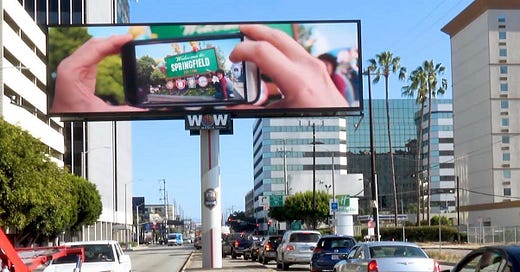I have written about rating billboards in the past. Some would be a 9, which is really good, while others would be a 5 or a 6, which is not so good. Let’s say we rode the state of Florida and saw over 150 boards, and our goal was an overall average of around 8-plus. Of course, the client always wants these to be a 10, even though we know that would never happen. Any board under a 6 gets changed immediately. These were not remnant buys, but large showing-level buys. Anything under a 6 was left for the guys from We Buy Ugly Houses.
We affectionally call this scoring philosophy “The Spore Score,” based on the late Jim Spore, an advertising buyer and manager for Geico. We would give Jim a printout of all the locations, a couple of red pens, and a clipboard. Then he scored every board the regional division had picked for his buy. At the end of the ride, he would hand off the score sheet—marked up in bloody red—to either myself or whoever else was conducting the market ride that day.
“Fix this,” Jim would say, then follow up with, “Make sure the average score of all these boards comes in no lower than 7.75.” So all it took was a few changes and we would accomplish that task, print a fresh location list with photos, and voila, we were done. The Spore Score never lied, so we were known to always have the best locations (that didn’t duplicate) spread around the market.
On one of my last rides with Jim in 2006, he looked back at me sitting in the backseat and said, “There, we don't need all those road counts and fancy inflated numbers. You just need to score each board based on what we see.”
Anyway, Jim was correct. Nowadays, there are companies with the sole purpose of trying to find a better way to analyze how effective an OOH product can be. But none of them give an actual 1-to-10 rating, which means a gussied-up photo with some heavy traffic nearby looks like Times Square, regardless of how badly it reads on paper. But in reality, it would probably be rated a 6.
Different angles, videos, and photos taken by drones or from roads with way lower traffic counts can manipulate the actual effectiveness of what could be a very short read, far off the road with a dwell time of literally two seconds. Having every OOH product rated, whether it’s a roadside static unit, a screen inside an elevator, a hotel lobby, your gas pump, or behind the counter at the convenience store would indicate the value those buying the space are receiving.
Is that feasible? It would be a lot of work, but all you’re looking for is one frigging number. That magic number along with an accurate daily impression count is really all anyone needs to make a smart media buy. It’s not magic and it shouldn't be as difficult as our industry is making it out to be.
I believe a universally accepted proper rating system in the U.S. would exponentially increase the amount of advertising spend in OOH. If you want all 10s, here’s the per-unit rate. If you’re happy with an average score of 7, you’ll pay less. You could also employ this method on transit buys.
My point has always been that regardless if a board is daily or weekly, give that product a rating, even if that is just a starting point. Imagine plugging in programmatically that you want all your digital locations rated 8 or above. Your overall cost would correspond with your scoring request and, once again, you have a smarter media plan.
Funny how a rating system that was once old could now be new. And easier.
The Spore Score. Someone’s gotta do this.
Nick Coston has been in the advertising industry for over 35 years. He’s worked at newspapers, magazines, OOH/DOOH companies, programmatic platforms, and ground-breaking ad tech companies, including Washingtonian, Washington Times, New Republic, USA Today Weekend, Clear Channel Outdoor, and The Neuron and Hypercell. He’s also spent 10 years buying OOH for a top 10 national advertiser. Nick resides with his family in Dayton, Maryland. He has been musing about the Outdoor Media industry for over five years.







Totally agree with you Nick. There should be an industry standard other than CPM